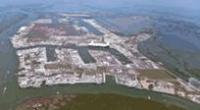
The Greater Lafourche Port Commission, located on the Gulf Coast in Louisiana, in partnership with national security firm, Crescent Guardian, Inc., has completed implementation of an advanced video analytics application developed by BRS Labs to accompany its next-generation video surveillance system.
This milestone ensures that first responders in Port Fourchon are receiving "as they happen" alerts identified automatically by the surveillance system and can coordinate their response in real time, states BRS Labs.
This level of data sharing and interoperability is unprecedented and will aid in lowering response times and overall situational awareness during real-time events, placing the port’s security among the most advanced in the nation.
The Greater Lafourche Port Commission’s is committed to continually improving the security and emergency response preparedness of Port Fourchon by building a Maritime Domain Awareness System that allows local, state and federal agencies, such as Harbor Police, Lafourche Parish Sheriff’s Office, LOOP [Louisiana Offshore Oil Port], Lafourche Parish EOC, Fire Central Dispatchers, GOHSEP, Department of Defense, Customs, and Coast Guard to collaborate effectively and become more proactive.
To do this, the port’s director of information technology, April Danos, wanted to find a way to take all technologies and disparate data and bring them into one common operating picture that would allow these several agencies to work collaboratively within the same situational awareness platform over multiple networks.
Crescent Guardian, Inc., a partner security firm of the port, developed an effective solution by providing advanced software that could run the new surveillance system for Fourchon’s Maritime Domain Awareness System, or GLPC-C4.
The cutting-edge software allows the system to send alerts and alarms if anomalous behavior is detected, meaning there are “no rules” to be written prior to their use — making it one of the easiest and most effective systems in the industry to install and use, says the news release.
Port Fourchon was developed as a multi-use facility the port commission?s Website. It has historically been a land base for offshore oil support services, as well as a land base for the LOOP. In addition, Port Fourchon has served as a commercial and recreational fishing mecca, foreign cargo shipping terminal, and a recreation and tourism area.
The overwhelming majority (more than 95 percent) of tonnage handled at the Port is oil and gas related, says the commission?s Website.
Every widget and gadget needed to support the oil and gas industry is handled as cargo. It moves through container, bulk, breakbulk, and just about every method imaginable.
Approximately 30 percent of total tonnage travels to and from the port by inland barge before being transferred to or from an offshore supply vessel, and 70 percent travels to and from the port by vehicle before being transferred to or from an offshore supply vessel or helicopter.
“The Port Commission was pleased to work with CGI to integrate BRS Labs’ video analytics into Port Fourchon’s video management system and the GLPC-C4 System,” said Danos.
The U.S. Department of Defense supported Port Fourchon’s efforts by sharing the DoD-developed capabilities of the Knowledge Display and Aggregation System (KDAS) to serve as the basis for the Port’s incident command and control system. The use of KDAS provides Port Fourchon with the unique ability to network its system with the DoD, in the event of an incident requiring information sharing.
Source: gsnmagazine.com
